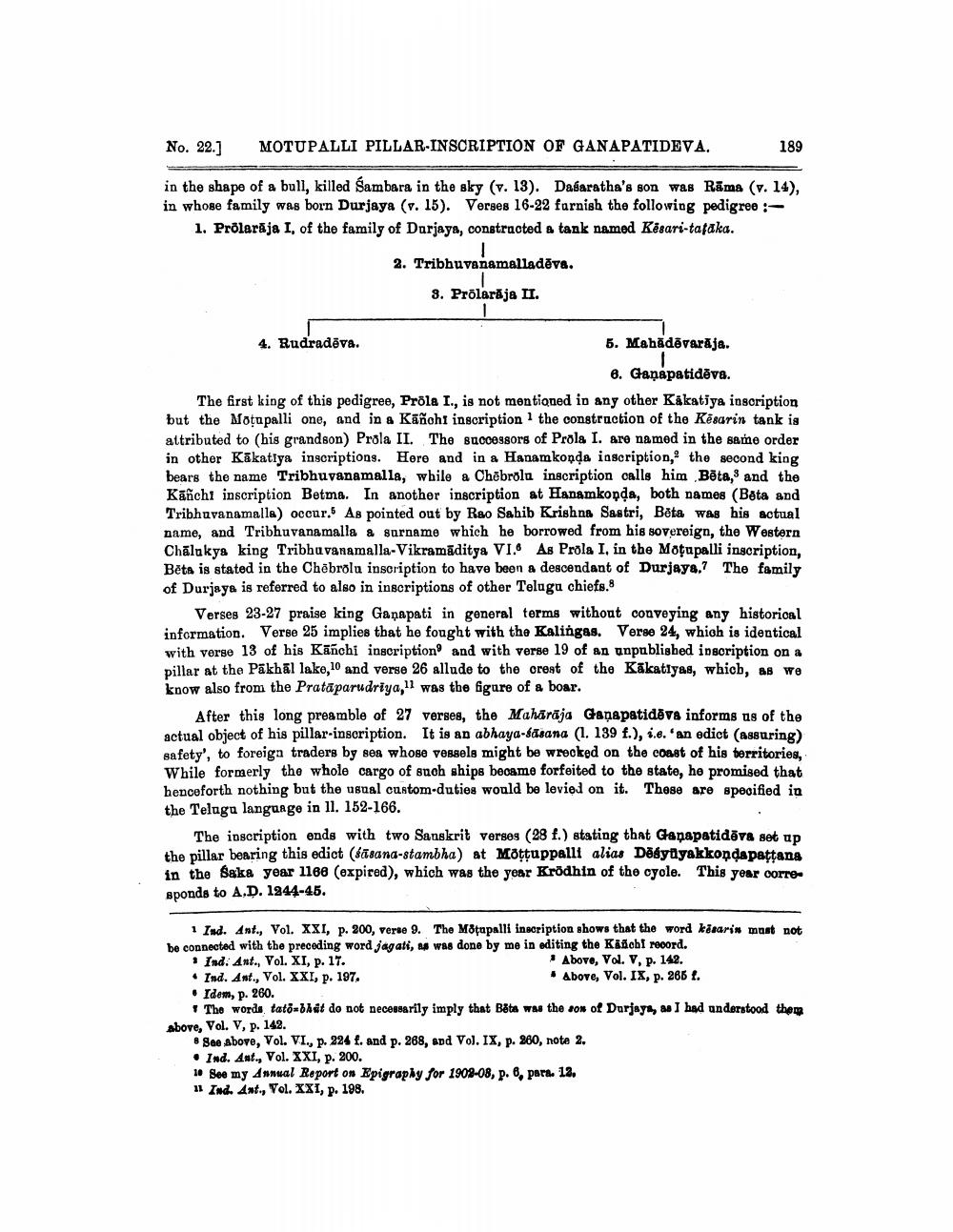________________
No. 22.]
MOTUPALLI PILLAR-INSCRIPTION OF GANAPATIDEVA.
in the shape of a bull, killed Sambara in the sky (v. 13). Dasaratha's son was Rāma (v. 14), in whose family was born Durjaya (v. 15). Verses 16-22 furnish the following pedigree :1. Prōlarāja I, of the family of Durjaya, constructed a tank named Kesari-taṭāka.
4. Rudradeva.
I
2. Tribhuvanamalladeva.
T
3. Prōlarāja II.
5. Mahādēvarāja. f
6. Gaṇapatidēva.
189
The first king of this pedigree, Prōla I., is not mentioned in any other Kakatiya inscription but the Motupalli one, and in a Kañcht inscription 1 the construction of the Kesarin tank is attributed to (his grandson) Prola II. The successors of Prola I. are named in the same order in other Kakatiya inscriptions. Here and in a Hanamkonda inscription, the second king bears the name Tribhuvanamalla, while a Chebrola inscription calls him Beta, and the Kanchi inscription Betma. In another inscription at Hanamkonda, both names (Beta and Tribhuvanamalla) occur. As pointed out by Rao Sahib Krishna Sastri, Beta was his actual name, and Tribhuvanamalla a surname which he borrowed from his sovereign, the Western Chalukya king Tribhuvanamalla-Vikramaditya VI. As Prola I, in the Motupalli inscription, Bēta is stated in the Chebrolu inscription to have been a descendant of Durjaya.? The family of Durjaya is referred to also in inscriptions of other Telugu chiefs.8
Verses 23-27 praise king Ganapati in general terms without conveying any historical information. Verse 25 implies that he fought with the Kalingas. Verse 24, which is identical with verse 13 of his Kanchi inscription and with verse 19 of an unpublished inscription on a pillar at the Pakhal lake, 10 and verse 26 allude to the crest of the Kakatiyas, which, as we know also from the Prataparudriya,11 was the figure of a boar.
After this long preamble of 27 verses, the Maharaja Ganapatideva informs us of the actual object of his pillar-inscription. It is an abhaya-sasana (1. 139 f.), i.e. 'an edict (assuring) safety', to foreign traders by sea whose vessels might be wrecked on the coast of his territories, While formerly the whole cargo of such ships became forfeited to the state, he promised that henceforth nothing but the usual custom-duties would be levied on it. These are specified in the Telugu language in 11. 152-166.
The inscription ends with two Sanskrit verses (28 f.) stating that Ganapatidēva set up the pillar bearing this edict (sasana-stambha) at Moṭṭuppalli alias Dosyayakkondapaṭṭana in the Saka year 1166 (expired), which was the year Krödhin of the cycle. This year corre sponds to A.D. 1244-45.
1 Ind. Ant., Vol. XXI, p. 200, verse 9. The Motapalli inscription shows that the word kesaris must not be connected with the preceding word jagati, as was done by me in editing the Käñchl record.
Ind. Ant., Vol. XI, p. 17.
Above, Vol. V, p. 142.
Ind. Ant., Vol. XXI, p. 197.
Above, Vol. IX, p. 265 f.
Idem, p. 260.
The words tato-bhat do not necessarily imply that Beta was the son of Durjaya, as I had understood them above, Vol. V, p. 142.
8 See above, Vol. VI., p. 224 f. and p. 268, and Vol. IX, p. 260, note 2.
Ind. Ant., Vol. XXI, p. 200.
See my Annual Report on Epigraphy for 1903-08, p. 6, para. 12, 11 Ind. Ant., Vol. XXI, p. 198.




